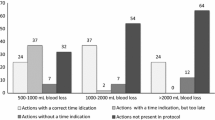Abstract
Objectives Obstetric hemorrhage is one of the leading causes of maternal mortality. The Florida Perinatal Quality Collaborative coordinates a state-wide Obstetric Hemorrhage Initiative (OHI) to assist hospitals in implementing best practices related to this preventable condition. This study examined intervention characteristics that influenced the OHI implementation experiences among Florida hospitals. Methods Purposive sampling was employed to recruit diverse hospitals and multidisciplinary staff members. A semi-structured interview guide was developed based on the following constructs from the intervention characteristics domain of the Consolidated Framework for Implementation Research: evidence strength; complexity; adaptability; and packaging. Interviews were audio-recorded, transcribed and analyzed using Atlas.ti. Results Participants (n = 50) across 12 hospitals agreed that OHI is evidence-based and supported by various information sources (scientific literature, experience, and other epidemiologic or quality improvement data). Participants believed the OHI was ‘average’ in complexity, with variation depending on participant’s role and intervention component. Participants discussed how the OHI is flexible and can be easily adapted and integrated into different hospital settings, policies and resources. The packaging was also found to be valuable in providing materials and supports (e.g., toolkit; webinars; forms; technical assistance) that assisted implementation across activities. Conclusions for Practice Participants reflected positively with regards to the evidence strength, adaptability, and packaging of the OHI. However, the complexity of the initiative adversely affected implementation experiences and required additional efforts to maximize the initiative effectiveness. Findings will inform future efforts to facilitate implementation experiences of evidence-based practices for hemorrhage prevention, ultimately decreasing maternal morbidity and mortality.
Similar content being viewed by others

References
Andreatta, P., & Marzano, D. (2012). Healthcare management strategies: Interdisciplinary team factors. Current Opinion in Obstetrics and Gynecology, 24(6), 445–452. doi:10.1097/GCO.0b013e328359f007.
Armstrong, C. E., Lange, I. L., Magoma, M., Ferla, C., Filippi, V., & Ronsmans, C. (2014). Strengths and weaknesses in the implementation of maternal and perinatal death reviews in Tanzania: Perceptions, processes and practice. Tropical Medicine and International Health, 19(9), 1087–1095. doi:10.1111/tmi.12353.
Belizan, J. M., Salaria, N., Valanzasca, P., & Mbizvo, M. (2014). How can we improve the use of essential evidence-based interventions? Reproductive Health, 11, 69. doi:10.1186/1742-4755-11-69.
Bingham, D., & Jones, R. (2012). Maternal death from obstetric hemorrhage. Journal of Obstetric, Gynecologic, and Neonatal Nursing, 41(4), 531–539. doi:10.1111/j.1552-6909.2012.01372.x.
Bingham, D., Lyndon, A., Lagrew, D., & Main, E. K. (2011). A state-wide obstetric hemorrhage quality improvement initiative. MCN The American Journal of Maternal Child Nursing, 36(5), 297–304. doi:10.1097/NMC.0b013e318227c75f.
Coding Analysis Toolkit. (2007–2015). Qualitative data analysis program. University Center for Social and Urban Research, University of Pittsburgh, Qualitative Data Analysis Program, College of Social and Behavioral Sciences, University of Massachusetts Amherst. Retrieved July 26, 2015 from http://cat.ucsur.pitt.edu/.
Creanga, A. A., Berg, C. J., Syverson, C., Seed, K., Bruce, F. C., & Callaghan, W. M. (2015). Pregnancy-related mortality in the United States, 2006–2010. Obstetrics and Gynecology, 125(1), 5–12.
Damschroder, L. J., Aron, D. C., Keith, R. E., Kirsh, S. R., Alexander, J. A., & Lowery, J. C. (2009). Fostering implementation of health services research findings into practice: A consolidated framework for advancing implementation science. Implementation Science, 4, 50. doi:10.1186/1748-5908-4-50.
Damschroder, L. J., & Hagedorn, H. J. (2011). A guiding framework and approach for implementation research in substance use disorders treatment. Psychology of Addictive Behaviors, 25(2), 194–205. doi:10.1037/a0022284.
Florida Perinatal Quality Collaborative. (2014). Florida obstetric hemorrhage initiative toolkit: A quality improvement initiative for obstetric hemorrhage management.
Hartzler, B., Lash, S. J., & Roll, J. M. (2012). Contingency management in substance abuse treatment: A structured review of the evidence for its transportability. Drug and Alcohol Dependence, 122(1–2), 1–10. doi:10.1016/j.drugalcdep.2011.11.011.
Kennedy, C., Finkelstein, N., Hutchins, E., & Mahoney, J. (2004). Improving screening for alcohol use during pregnancy: The Massachusetts ASAP program. Maternal and Child Health Journal, 8(3), 137–147.
Lash, S. J., Timko, C., Curran, G. M., McKay, J. R., & Burden, J. L. (2011). Implementation of evidence-based substance use disorder continuing care interventions. Psychology of Addictive Behaviors, 25(2), 238–251. doi:10.1037/a0022608.
Lee, H. C., Powers, R. J., Bennett, M. V., Finer, N. N., Halamek, L. P., Nisbet, C., & Sharek, P. J. (2014). Implementation methods for delivery room management: A quality improvement comparison study. Pediatrics, 134(5), e1378–e1386. doi:10.1542/peds.2014-0863.
Levison, J., Williams, L. T., Moore, A., McFarlane, J., & Davila, J. A. (2011). Increasing use of rapid HIV testing in labor and delivery among women with no prenatal care: A local initiative. Maternal and Child Health Journal, 15(6), 822–826. doi:10.1007/s10995-010-0636-1.
McHugh, M. L. (2012). Interrater reliability: The kappa statistic. Biochemia medica (Zagreb), 22(3), 276–282.
Morris, Z. S., Wooding, S., & Grant, J. (2011). The answer is 17 years, what is the question: Understanding time lags in translational research. Journal of the Royal Society of Medicine, 104(12), 510–520. doi:10.1258/jrsm.2011.110180.
Nikolopoulos, H., Farmer, A., Berry, T. R., McCargar, L. J., & Mager, D. R. (2015). Perceptions of the characteristics of the Alberta Nutrition Guidelines for Children and Youth by child care providers may influence early adoption of nutrition guidelines in child care centres. Maternal and Child Nutrition, 11(2), 271–282. doi:10.1111/j.1740-8709.2012.00460.x.
Porter, K. J. (2013). Bringing nutrition education programs from outside sources into the classroom: The experience of New York City public elementary schools. (PhD), Columbia University, New York. Retrieved from http://search.proquest.com/docview/1372009019?accountid=14745. ProQuest Dissertations & Theses Full Text database database.
Rabin, B. A., Brownson, R. C., Haire-Joshu, D., Kreuter, M. W., & Weaver, N. L. (2008). A glossary for dissemination and implementation research in health. Journal of Public Health Management and Practice, 14(2), 117–123. doi:10.1097/01.PHH.0000311888.06252.bb.
Robins, L. S., Jackson, J. E., Green, B. B., Korngiebel, D., Force, R. W., & Baldwin, L. M. (2013). Barriers and facilitators to evidence-based blood pressure control in community practice. The Journal of the American Board of Family Medicine, 26(5), 539–557. doi:10.3122/jabfm.2013.05.130060.
Ryan, R. W., Harris, K. K., Mattox, L., Singh, O., Camp, M., & Shirey, M. R. (2015). Nursing leader collaboration to drive quality improvement and implementation science. Nursing Administration Quarterly, 39(3), 229–238. doi:10.1097/naq.0000000000000111.
Saldaña, J. (2009). The coding manual for qualitative researchers. Thousand Oaks, CA: Sage.
Segre, L. S., Brock, R. L., O’Hara, M. W., Gorman, L. L., & Engeldinger, J. (2011). Disseminating perinatal depression screening as a public health initiative: A train-the-trainer approach. Maternal and Child Health Journal, 15(6), 814–821. doi:10.1007/s10995-010-0644-1.
Serruya, S. J., Duran, P., Martinez, G., Romero, M., Caffe, S., Alonso, M., & Silveira, M. F. (2015). Maternal and congenital syphilis in selected Latin America and Caribbean countries: A multi-country analysis using data from the Perinatal Information System. Sexual Health. doi:10.1071/sh14191.
Shah, V., Warre, R., & Lee, S. K. (2013). Quality improvement initiatives in neonatal intensive care unit networks: Achievements and challenges. Academic Pediatric, 13(6 Suppl), S75–S83. doi:10.1016/j.acap.2013.04.014.
Sorensen, J. L., & Kosten, T. (2011). Developing the tools of implementation science in substance use disorders treatment: Applications of the consolidated framework for implementation research. Psychology of Addictive Behaviors, 25(2), 262–268. doi:10.1037/a0022765.
Acknowledgments
This project was supported by funds from the Florida Department of Health. We would like to thank all of the hospitals and multidisciplinary staff members who participated in this study for their time and willingness to share their candid experiences implementing this quality improvement initiative.
Author information
Authors and Affiliations
Corresponding author
Rights and permissions
About this article
Cite this article
Vamos, C.A., Cantor, A., Thompson, E.L. et al. The Obstetric Hemorrhage Initiative (OHI) in Florida: The Role of Intervention Characteristics in Influencing Implementation Experiences among Multidisciplinary Hospital Staff. Matern Child Health J 20, 2003–2011 (2016). https://doi.org/10.1007/s10995-016-2020-2
Published:
Issue Date:
DOI: https://doi.org/10.1007/s10995-016-2020-2



